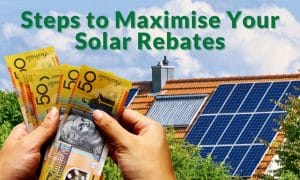Australians from all walks of life are feeling the pinch right now. Inflation and rising interest rates have many scared to walk to their letterbox. What awaits them inside, nestled inside an envelope, may just be a bill they might not be able to pay. If this is you, you may be wondering how in the world you could possibly afford to add a solar system to your home.
It’s no secret that solar, whether big or small, can cost thousands to install. You’re probably well aware of the benefits of solar, but we’re here today to discuss how the benefits can be reaped almost immediately. What’s more, you may be able to afford to do it now.
Saving you money the moment solar is connected
If you’re familiar with the share market, then you’ll no doubt know that patience is a virtue! Turning a profit can sometimes mean investing in shares that may not provide a return for weeks, months, or years. Other investments often rely on a future sale of the asset – and the profit will be subject to tax in most cases. This is where solar is vastly different.
Profits/savings from solar are found in two ways:
- The use of solar will see a saving on your bill
- The exporting of unused solar will see a credit on your bill
The savings will begin the moment your solar system is connected to the grid and active through your electricity retailer. Every kilowatt hour (kWh) of electricity you use from solar will be one less kWh of electricity you use from the grid. This is an instant saving. If your system is large enough, and you use it to its maximum capacity, your bills might end up being $0 per month, or even in credit if you are able to export as well.
How can I afford to go solar?
Reading about potential savings and profit is all well and good, but if you can’t afford solar then it’s all wishful thinking. Or is it? There are a number of options available to all Australians*, and some are available depending on where you live.
$0 upfront and interest-free financing
Did you know that most solar retailers (the people who will sell you and install your solar system) offer $0 upfront and interest-free financing*? This isn’t a gimmick or a scam. As an example: If you were to purchase a 6.6kW solar system for $5,000, you might choose to have this financed.
Instead of paying $5,000 upfront, you could pay approximately $150 per month, for the term of the loan (usually 4 years). This may seem like a lot, but let’s break it down.
If your quarterly electricity bills are $1,000, and your bills are reduced by just 30% due to solar, that is a saving of $300 per quarter. This will mean that you will only be out of pocket $50 per month for your solar – or $600 per year for 4 years.

After the fourth year, your system will be paid off. The $300 saved per quarter will be pure savings for the lifespan of your solar. Your solar panels will have a warranty of 25 years – so that’s 21 years of savings!
This is also not factoring in the ever-increasing electricity rates. $1,000 per quarter now may be $1,100 per quarter the next year. Many households who install solar with financing end up cash flow positive – that is, the solar savings completely offset the cost of the repayments. In fact, the savings of solar can often be calculated by $400 per year per kW of solar generation capacity. So a 5kW system could save you $400 x 5 = $2,000 per year!
There are some caveats. A merchant fee, as well as an establishment fee, will usually be built into the total finance amount. A $5,000 system may end up costing you $6,500. So while the finance may be interest-free, you will be paying more than if you were to pay in total upfront.
Green Loans
Green Loans are available in all states to all Australians*. These loans are available through all major banks and lenders and have special lending criteria. The main attraction of a green loan is the low interest rate compared to other loans, generally averaging around 5.5%. These loans are available for specific purchases of renewable energy technology, such as solar systems.

For example, our 6.6kW system at $5,000 may be eligible for a 5.99% green loan at a repayment rate of $55 per fortnight for 4 years.
Just like interest-free financing, the loan repayments can be partially or fully offset by the solar savings. But, just like financing, there are caveats. Green loans can attract establishment fees (usually less than $100) and are subject to stringent lending criteria.
Power Purchase Agreements
Did you know that you can effectively lease out your roof whilst reaping the benefits of solar? Power Purchase Agreements (PPA) are a purchase agreement between you and a retailer whereby they will install solar and a battery on your home for no upfront cost. You will pay a fixed monthly fee (the amount will be dependent on the size of the system) and receive a guaranteed amount off your electricity bills. The term of the agreement is usually 10 years, with the option to purchase the system or upgrade at the end of the term. You will also be able to purchase the system, usually, at any point during the term of the agreement, usually at a reduced rate as determined by the retailer.
PPAs often also attract the option to participate in a Virtual Power Plant (VPP). If you have a battery, you will be able to discharge the stored electricity during VPP events (when the grid requires additional electricity). You will be paid a premium for the amount of kWh of electricity you send to the grid.
The benefit of PPAs is that the retailer will maintain the system for you for the term of the agreement. There are no upfront costs and no nasty surprises – you pay a fixed fee every month with a guaranteed return. Energy Matters has partnered with Powow which offers PPAs and VPPs.
State rebates and loans
Victoria is the place to be for solar! The Victorian government provides $1,400 rebates on the purchase of solar systems. In addition, they also provide interest-free loans up to the amount of the rebate ($1,400) to be repaid over 4 years.
The ACT has interest-free loans of up to $15,000 for eligible applicants which are paid off over 10 years (or less if you choose)! In addition, they also offer rebates of up to 50% of the installation price of a solar system, up to $2,500.
You can find out if your state has any rebates, subsidies, or incentives to go solar here.
*Subject to lending criteria. All figures are intended to be used as a guide and should not be substituted for professional financial advice.
Going solar now to save for the future
The previous average yearly increase in electricity rates was 5%, but this has since risen to 25%! Going solar now locks in your savings now. Waiting just another year could see a loss of over $1,000 of potential savings. Moving away from gas will also see many household electricity bills increase. Now is the time to get solar!
Solar is an investment with a guaranteed return. The sun will be shining on your roof whether you capture it or not, so why not put your roof to work?!
We recommend speaking with solar retailers who will be able to tell you exactly how you can afford to go solar now and what you can expect to save. Energy Matters provides a 100% FREE solar quotes service. We connect Australians with up to 3 solar installers in their local area who will provide them with free quotes for solar, batteries, and more. Get your free quotes today!












































